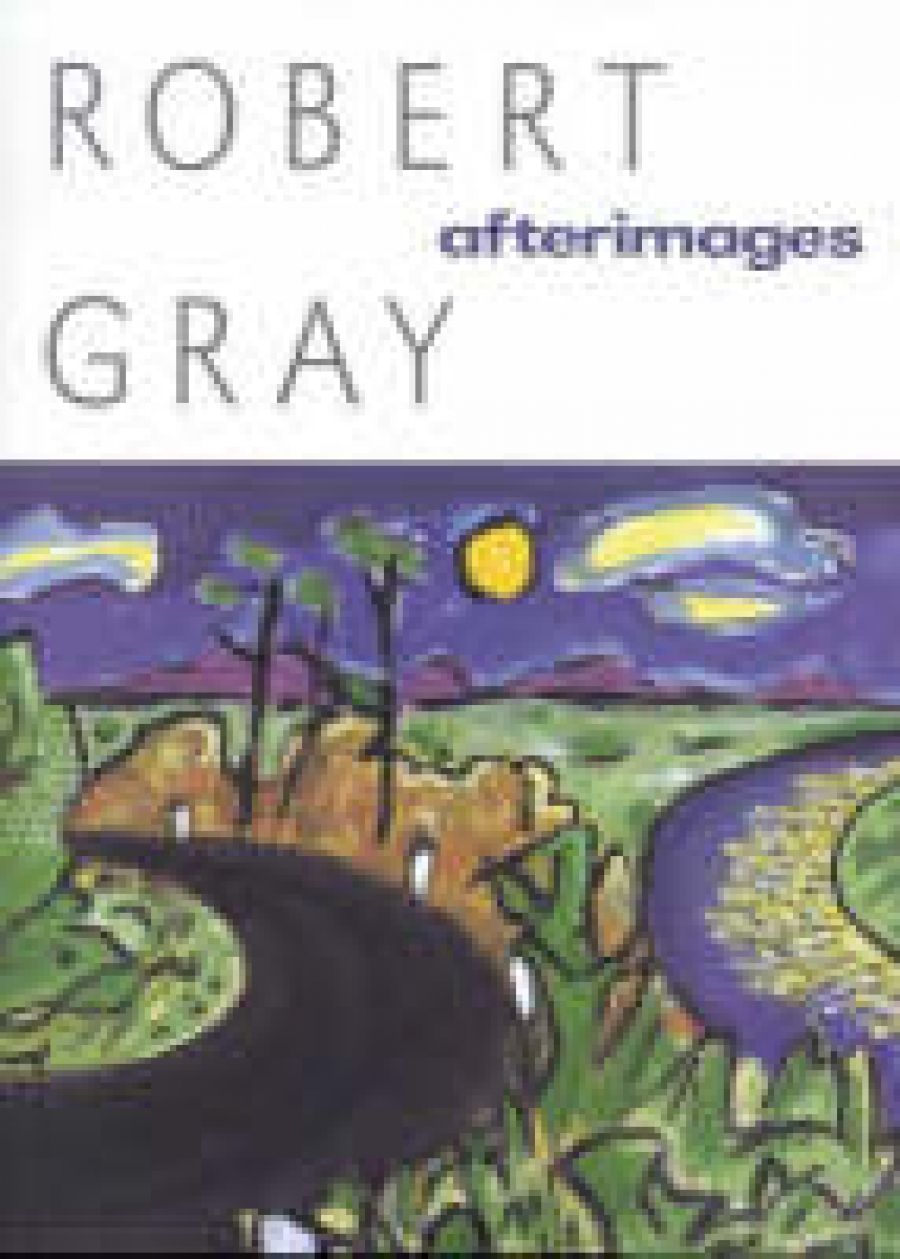
- Free Article: No
- Contents Category: Poetry
- Review Article: Yes
- Custom Highlight Text: Robert Gray’s new book continues the style of his previous one, Lineations, by interspersing poems with drawings: there are three panels of six drawings each, spaced throughout the book. It also contains a long meditation on things and thinginess, reality, consciousness (and all stops between) called ‘The Drift of Things’ ...
- Book 1 Title: Afterimages
- Book 1 Biblio: Duffy & Snellgrove, $22 pb, 76 pp, 9781876631228
If things ‘flow into one another / as quietly as smoke’ and are the ‘glittering smoke of the world’, it comes as no surprise that images of fluid mobility dominate Gray’s work. ‘Damp Evening’ is structurally, for example, a vertical view of successive strata of background with an object – a ferry – moving laterally in the foreground, while ‘In the Mallee’ has a typically brilliant image of the way a fox moves: ‘It is flowing away from here obliquely, with an averted / shy face’. Gray’s imagination responds to this kind of movement: it is hard to forget the image in his previous book of elephants doing a soft shoe shuffle ‘swaying weightlessly, like plants underneath the ocean’.
But, unlike smoke, which rises through the air, the unavoidable recurrent image in Afterimages is that of rain. It is a book where rain can appear as a cyclonic rage against an ugly mercantilism (‘Cyclone’) or as the setting for a guilt-ridden, pre-dawn meditation (‘Chameleon’). It seems that rain symbolises the downward drift of things, not towards entropy – because everything is continuously recombined – but towards death. In Wallace Stevens’s phrase, everything moves ‘downwards to darkness on extended wings’. And one of the other major themes of the book is loss; although it is loss that evokes not rage or frustration so much as a calmer observation of the process of dissolution.
The book begins with a poem in which the author moves from the world of books to a rain-soaked natural world, ‘into this richness, the rot of flowers’, although the direction of the movement in the poem is not unequivocal. It is followed by a poem with all the trappings of an Edwardian cricket scene but whose burden is the passing of youth and the erotic love of the body.
The poem that best combines dispassionate observation with an intense emotional stake is the poem on Gray’s mother’s decline into Alzheimer’s, ‘The Dying Light’. The dispassion is in the tone; it is not neutrally written but a mixture of the solemn, the intense and the comic – a series of tones that cancel each other out. But there is dispassion also in the metaphors. It is a feature of Gray’s style to run a group of metaphors up to a subject as though turning it in the light. When he pushes his mother in a wheelchair and she habitually leans sideways, it is as though ‘she is being sucked out of existence sideways through a portal’, or as though she is in a motorcycle race as ‘the sidecar passenger / who keeps the machine on the road’.
Unsurprisingly, it is the religious promises of something transcending life that irritate the author as he comes to grips with his mother’s journey through this life: ‘there are hierarchies in Heaven, we remember; and we know / of its bungled schemes.’ Its final lines are simultaneously a memorable rebuttal of the problematic theology of an afterlife; a cry of despair at the cruel processes of dissolution that take place in our one and only life; and an expression of belief that peace is found only in the acceptance of our physical destruction:
She will be safe
in the dry mouth
of this red earth, in the place
she has always been. She
who hasn’t survived living, how can we dream that she will
survive her death?
One of the intriguing moments of this poem is the recording of his mother’s declining powers of speech or, rather, her declining ability to find the correct lexical item:
In our sitting about
she has also said, relevant of nothing, ‘The desert is a tongue.’
‘A red tongue?’
‘That’s right, it’s a
it’s a sort of
you know — it’s a — it’s a long
motor car.’
She has become, says the poem, a surrealist poet. This leads me to a subject that often arises in discussions of Gray’s work: rationality and metaphor. To put it crudely, the concern is whether a rationally defensible metaphor establishes a hierarchy so that (in classical terms) the vehicle is inferior to the tenor. Certainly, Gray’s use of metaphor is unusual. If, in the light of ‘The Drift of Things’, we see every object as having the power to illuminate all other objects, then this explains Gray’s tendency to use metaphor as a forensic device. Hence the tendency almost to ‘try out’ comparisons for their capacity to illuminate.
This is done brilliantly in ‘Flemington Races’. It is not a profound poem – it concludes with the unoriginal, if comforting, proposition that the horses, in their brute physicality, are more dignified than their connections – but it does exemplify just how powerful Gray’s metaphoric mode is. The poem begins with a sentence containing four diverse metaphors and goes on to describe the running of the horses around the back straight; another image of fluid motion. There are three rapid-fire metaphors: the horses are ‘elongated as foxes’, they run together like ‘a suburban train’ or a ‘roller-skate derby, with only the crouched figures visible above the fence, queued and clinging to each other, drifting fast into the long bend on wheels’. To me, initially, it is not a logical set of comparisons and, put together, it can cause some odd images. But the technique is pragmatically designed both to assist visualisation and to reveal the significance of motion, and it certainly does both wonderfully.


Comments powered by CComment